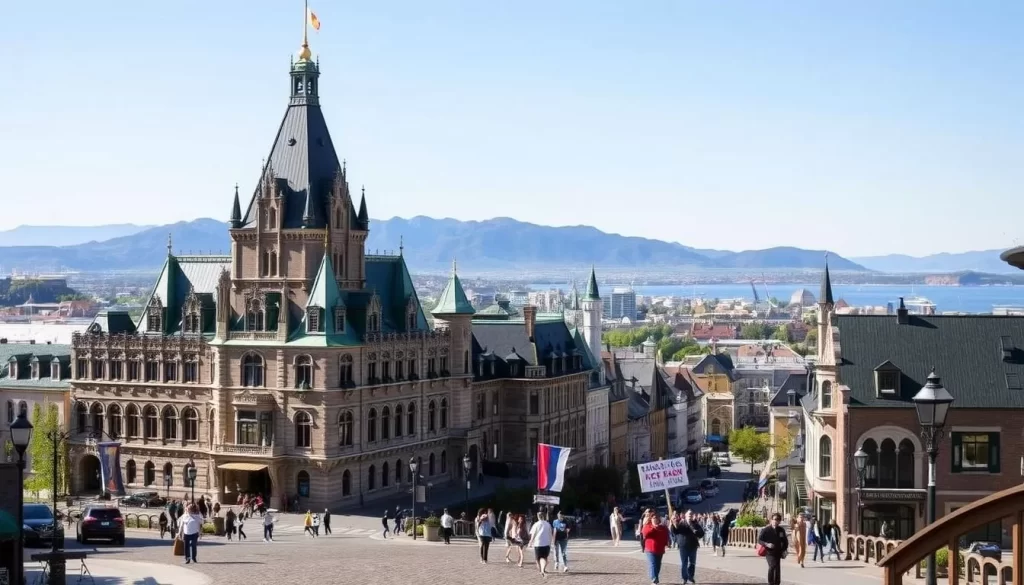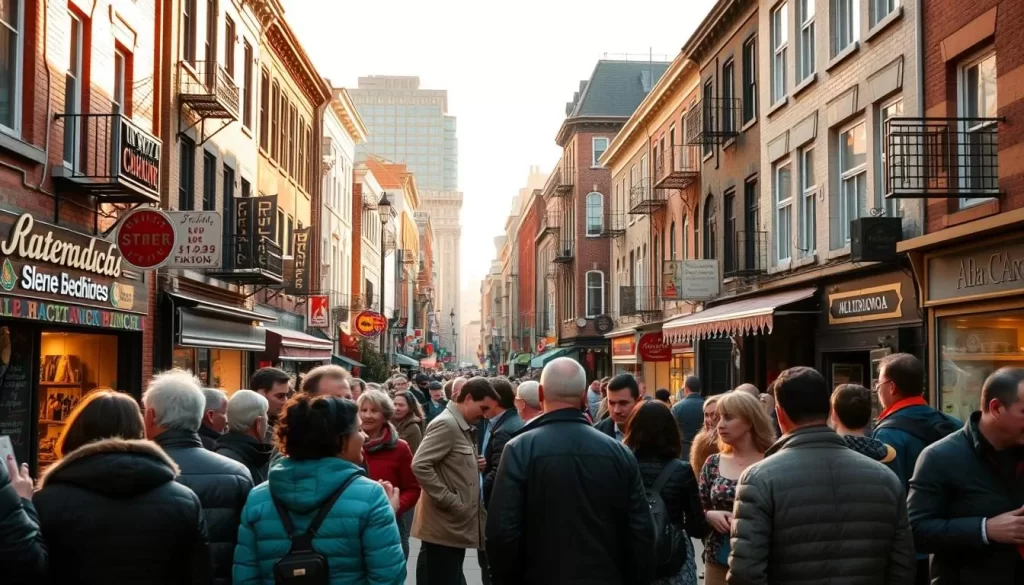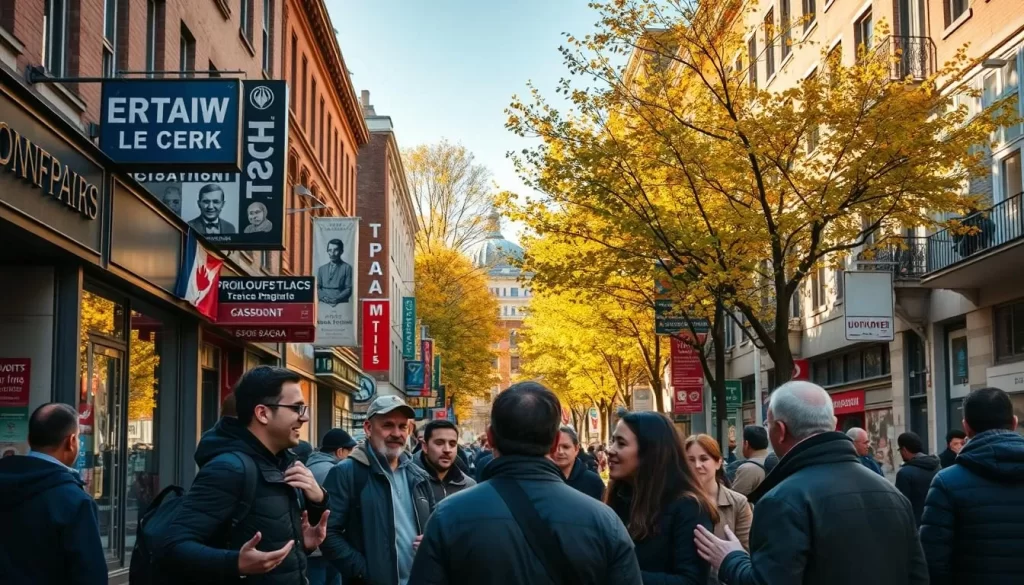✓ Accommodations✓ Flights✓ Rental Cars
Have you ever wondered what makes Quebec’s linguistic landscape so unique? This province stands out for its rich cultural heritage and its commitment to preserving its primary official language: French.
French isn’t just a language here; it’s a cornerstone of identity. Over 84% of the population speaks it as their first official language, making it the heart of daily life.
But that’s not all. Quebec is also home to a growing bilingual community. Many residents speak both French and English, reflecting the province’s diverse cultural fabric.
In this article, you’ll explore how history, demographics, and policies shape Quebec’s language practices. Get ready to dive into fascinating insights about how language connects people and cultures in this vibrant region.
Overview of Quebec’s Language Landscape
Understanding Quebec’s language dynamics requires a look into its past and present. The region’s linguistic journey began with French colonization in the 1600s. Over time, it evolved into a unique blend of english french influences, shaping the way people communicate today.
In the early days, French was the dominant language spoken. It became the first official language, deeply rooted in the culture. By the 2011 census, nearly 95% of the population reported the ability to speak French. This highlights its enduring significance.
Modern influences have added layers to this linguistic tapestry. Immigration and globalization introduced new languages, creating a diverse community. While French remains the mother tongue for 78% of the population, English and other languages are also widely used.
Here’s a quick breakdown of language usage in Quebec:
| Language | Percentage of Speakers |
|---|---|
| French | 95% |
| English | 8% |
| Other Languages | 7% |
These shifts reflect how history and modern trends shape Quebec’s language spoken practices. As you explore further, you’ll see how these dynamics influence daily life and cultural identity.
Demographic Snapshot of Quebec’s Linguistic Diversity
The 2021 census reveals fascinating insights into linguistic diversity. It highlights how language use has evolved over time, offering a clear picture of current trends.
According to the data, 93.7% of the population has knowledge of French. This shows its continued dominance in daily life. English, while less prevalent, is spoken by 14.9% of residents, reflecting a growing bilingual community.
Insights from the 2021 Census
The census provides a detailed breakdown of language use. French remains the primary language for 84.1% of the population, while English is the first language for 13.0%. Bilingualism is also on the rise, with 46.4% of residents fluent in both languages.
| Language | Percentage of Speakers |
|---|---|
| French | 84.1% |
| English | 14.9% |
| Bilingual (French & English) | 46.4% |
Population and Usage Trends
Over the years, language demographics have shifted. The proportion of French speakers has slightly decreased, while English and bilingual populations have grown. These changes reflect the region’s evolving cultural landscape.
The 2021 census also highlights the importance of bilingualism. Nearly 70% of English speakers and 42.8% of French speakers are bilingual. This trend underscores the value of multilingualism in fostering communication and cultural understanding.
Quebec, Canada: Official and widely spoken languages
The linguistic identity of Quebec is shaped by its strong commitment to French as its primary language. This dedication is reflected in its official languages policies, which ensure French remains central to public life.
Public services in the province are designed to prioritize French while also accommodating other languages. This balance allows residents to access essential information in their preferred language.

Recent data highlights the sheer number of French speakers in the region. Over 95% of the population can converse in French, making it the dominant language. Additionally, bilingualism is on the rise, with nearly half of residents fluent in both French and English.
Government policies play a crucial role in shaping language use. These measures ensure French remains the primary language in education, media, and public services. At the same time, they support the growing diversity of languages spoken across the province.
Quebec’s unique approach to language preservation and adaptation makes it a fascinating case study. Its policies not only protect French but also foster a multilingual environment that reflects its cultural richness.
The Dominance of the French Language in Quebec
The french language stands as a cornerstone of identity in Quebec, deeply embedded in its culture and daily life. Over 93% of the population can converse in French, making it the majority language. This dominance is not just a statistic; it’s a reflection of the region’s heritage and values.
Families and communities play a vital role in preserving the mother tongue. From childhood, French is taught and spoken at home, ensuring its continuity across generations. This cultural transmission strengthens the language’s roots in society.
Government policies also reinforce the french language’s prominence. Laws like Bill 101 ensure French is the primary language in education, business, and public services. These measures protect its status while fostering a sense of unity among residents.
Here’s a quick look at the linguistic landscape:
| Language | Percentage of Speakers |
|---|---|
| French | 93.72% |
| English | 51.96% |
| Other Languages | 13.15% |
The majority usage of French shapes every aspect of life, from education to business. Schools prioritize French instruction, while workplaces often require bilingual skills, blending french english proficiency. This linguistic dominance creates a unique cultural identity that sets Quebec apart.
“French is not just a language here; it’s a way of life.”
In essence, the french language is more than a means of communication. It’s a symbol of pride, heritage, and unity, deeply woven into the fabric of Quebec’s society.
English Language Presence and Its Cultural Impact
The presence of English in Quebec adds a unique layer to its cultural fabric. While French dominates, the english language plays a significant role, especially in urban centers like Montreal. This bilingual dynamic fosters a vibrant environment for cultural exchange.
Historically, English-speaking communities have roots dating back to the 18th century. Over time, this group has grown, contributing to the province’s diversity. Today, Montreal stands as a hub for english english-speaking residents, offering a blend of traditions and modern influences.
English’s influence extends beyond daily conversations. It shapes media, education, and business, creating a bridge for cross-border communication. For instance, Montreal’s English-language newspapers and radio stations cater to a wide audience, reflecting its multicultural identity.
Here’s a snapshot of English language usage in key areas:
| Region | English Speakers (%) |
|---|---|
| Montreal | 10.5 |
| Quebec City | 1.9 |
| Other Regions | 7.0 |
Bilingualism is a key factor in this cultural blend. Many residents seamlessly switch between French and English, enriching their interactions. This linguistic flexibility not only strengthens community bonds but also opens doors to global opportunities.
In essence, the english language in Quebec is more than a secondary tongue. It’s a vital part of the province’s identity, shaping its cultural landscape and fostering connections across borders.
Exploring Allophones and Multilingual Communities
Allophones play a crucial role in enriching the province’s cultural tapestry. These individuals, whose first language is neither French nor English, bring a wealth of linguistic diversity to the region. Over 30 different native tongues are spoken, particularly in urban centers like Montreal.

Immigrant Languages and Community Integration
Immigrant communities are vital to Quebec’s demographic evolution. They maintain their native tongues while integrating into the broader society. This dual approach fosters a unique blend of cultural preservation and adaptation.
According to recent data, around 13% of residents are allophones. This group represents a growing segment of the population, contributing to the rise of multilingual households. Such diversity enhances social interactions and broadens cultural understanding.
Here’s a breakdown of the most common immigrant languages:
| Language | Percentage of Speakers |
|---|---|
| Arabic | 3.5% |
| Spanish | 2.8% |
| Mandarin | 2.1% |
Community integration initiatives play a key role in supporting this diversity. Programs encourage the use of native tongues at home while promoting French and English proficiency. This balanced approach ensures that linguistic heritage is preserved alongside societal integration.
However, challenges exist. Language barriers can hinder access to education and employment. Addressing these issues requires targeted policies and community-driven solutions.
In essence, allophones and multilingual communities are shaping Quebec’s future. Their contributions enrich the cultural landscape, making the province a vibrant hub of linguistic diversity.
Understanding Mother Tongue Versus Home Language
Language plays a key role in shaping identity, but how do we define its roots? The terms mother tongue and home language often come up in discussions about linguistic practices. While they may seem similar, they represent distinct aspects of how we communicate.
Definitions and Comparative Insights
Your mother tongue is the first language you learn, usually from your family. It’s deeply tied to your cultural heritage. On the other hand, your home language is what you speak most often in daily life. These two can differ, especially in multilingual households.
Why does this distinction matter? It helps us understand language retention and usage patterns. For example, census data shows that 20.6% of people report a mother tongue other than English or French, but only 6.2% speak it exclusively at home. This gap highlights how languages evolve over time.
Here’s a quick comparison:
| Term | Definition |
|---|---|
| Mother Tongue | First language learned |
| Home Language | Language most often spoken at home |
Understanding these terms is crucial for interpreting demographic data. It reveals how languages are preserved or adapted across generations. For instance, 63.5% of people with a non-English or French mother tongue reported speaking English at home in 2011. This shift reflects broader societal influences.
In essence, your mother tongue connects you to your roots, while your home language reflects your current reality. Both are vital in understanding linguistic identity and its evolution.
Bilingualism Trends and Their Benefits
Bilingualism is becoming a defining feature of modern society, especially among younger generations. In recent years, the ability to speak two languages has grown significantly, offering both personal and professional advantages. This trend is particularly evident in regions where cultural diversity thrives.
The current rate of bilingualism has seen a steady increase. From 2001 to 2021, proficiency in both English and French rose from 40.8% to 46.4%. This growth highlights the growing importance of multilingual skills in today’s world.
Statistical Growth and Youth Perspectives
Young people are leading the charge in embracing bilingualism. For those aged 10 to 44, the bilingualism rate increased by over 12 percentage points between 2001 and 2021. This shift reflects the value younger generations place on language proficiency.
Bilingual education programs play a key role in this trend. Schools offering immersion programs have seen higher success rates in producing fluent bilingual speakers. For example, 60.8% of students who attended French-language schools or immersion programs outside Quebec became bilingual.
For students, bilingualism opens doors to global opportunities. It enhances cognitive abilities, improves problem-solving skills, and fosters cultural understanding. These benefits extend beyond the classroom, preparing them for a competitive job market.
Professionals also gain from bilingual knowledge. In industries like tourism, education, and international business, fluency in multiple languages is a valuable asset. It not only boosts career prospects but also strengthens cross-cultural communication.
In essence, bilingualism is more than just a skill—it’s a bridge to broader horizons. As more people recognize its advantages, the trend is likely to continue shaping societies for years to come.
Regional Variations: Montreal and Beyond
Language patterns shift dramatically across different regions, offering a fascinating glimpse into cultural diversity. In Montreal, you’ll find a vibrant mix of languages, reflecting its status as a multicultural hub. Over 30 different native tongues are spoken here, making it a unique linguistic area.

Outside Montreal, the linguistic landscape changes. Many regions remain predominantly francophone, with French being the primary language. For example, in rural areas, nearly 95% of the population speaks French as their first language. This contrasts sharply with Montreal’s multilingual environment.
Here’s a quick comparison of language usage across key areas:
| Region | Primary Language | Percentage of Speakers |
|---|---|---|
| Montreal | Multilingual | 30+ languages |
| Quebec City | French | 95% |
| Rural Areas | French | 93% |
When comparing Montreal to urban centers in British Columbia, similarities emerge. Both are melting pots of cultures, where multiple languages coexist. However, the influence of French in Montreal sets it apart, while English dominates in British Columbia.
Factors like immigration, urbanization, and historical ties shape these regional differences. Montreal’s diverse communities contribute to its multilingualism, while other areas maintain a stronger connection to their francophone roots. Understanding these variations helps you appreciate the rich cultural dynamics at play.
For more insights into Canada’s linguistic landscape, explore this detailed overview.
Language Legislation and Policy Developments
Language policies in Quebec have evolved significantly over the years, shaping its unique linguistic identity. These laws aim to protect and promote French, ensuring it remains central to public life. The government has played a key role in this process, enacting reforms that reflect the region’s cultural priorities.
One of the most impactful laws is the Charter of the French Language, passed in 1977. This legislation made French the sole official language of the province, requiring its use in business and government services. Over time, this law has shaped the linguistic landscape, reinforcing French as the dominant language.
Key Laws and Recent Reforms
Recent reforms, like Bill 96, have further strengthened the status of French. Adopted in May 2022, this law expands the use of French in workplaces, education, and public spaces. It also introduces stricter requirements for businesses to operate in French.
These changes reflect the ongoing debate about balancing language preservation with individual rights. While some applaud the efforts to protect French, others raise concerns about accessibility for non-French speakers. This tension highlights the complexity of language policy in a diverse society.
For a deeper understanding of these efforts, explore Canada’s Action Plan for Official Languages. This initiative outlines strategies to promote linguistic equality and support bilingual communities.
In essence, Quebec’s language laws are more than just regulations. They are a reflection of its cultural values and commitment to preserving its heritage. As policies continue to evolve, they will shape the region’s linguistic future for generations to come.
Impact of Immigration on Quebec’s Language Dynamics
Immigration has reshaped the linguistic fabric of Quebec in profound ways. Newcomers bring a wealth of languages, enriching the region’s cultural mosaic. This diversity is evident in the growing allophone population, which introduces a wide array of mother tongues and home languages.
Recent datum highlights this shift. For instance, nearly 50% of new immigrants originate from Asia, and a significant portion speak neither French nor English upon arrival. This trend underscores the evolving linguistic landscape, where multiple languages coexist and thrive.
Immigrant communities play a vital role in shaping language use. Many maintain their native tongues while integrating into broader society. This dual approach fosters cultural preservation and adaptation, creating a unique blend of traditions and modern influences.
Here’s a snapshot of how immigration influences language diversity:
| Language Group | Percentage of Speakers |
|---|---|
| French | 84.1% |
| English | 14.9% |
| Other Languages | 13.0% |
Challenges arise alongside these benefits. Language barriers can hinder access to education and employment. Addressing these issues requires targeted policies and community-driven solutions.
On the flip side, increased immigration fosters bilingualism and multilingualism. Many persons seamlessly switch between languages, enriching their interactions. This linguistic flexibility strengthens community bonds and opens doors to global opportunities.
“Immigration is not just about numbers; it’s about the stories and languages people bring with them.”
For a deeper dive into how immigration shapes language dynamics, explore this detailed analysis.
In essence, immigration is a driving force behind Quebec’s linguistic evolution. It enriches the cultural landscape, making the region a vibrant hub of diversity and communication.
Socio-Economic Factors Shaping Language Usage
Socio-economic factors play a pivotal role in shaping how languages are used and integrated in a community. From employment opportunities to education systems, these elements influence language retention and shift. Understanding this dynamic helps explain why certain languages thrive while others adapt or fade.

The Role of Employment and Education
The job market significantly impacts language preferences. For instance, workers in industries like tourism or international trade often prioritize bilingual skills. This demand encourages individuals to learn additional languages, fostering a multilingual environment.
Education systems also play a crucial role. School boards implement programs that promote language learning, ensuring children grow up with strong linguistic foundations. For example, immersion programs in schools have been shown to enhance fluency in both French and English.
Here’s how socio-economic factors influence language usage:
- Employment: Workers in diverse industries often adopt bilingualism to meet job requirements.
- Education: School boards design curricula that prioritize language learning, shaping future generations.
- Family Dynamics: Children often inherit their parents’ language habits, but economic factors can lead to shifts over time.
Economic status further influences language patterns. Families with higher incomes may invest in private language classes, while others rely on public education systems. This disparity can lead to varying levels of language proficiency across social groups.
In essence, socio-economic factors are deeply intertwined with language usage. They shape how languages are learned, preserved, and adapted, creating a dynamic linguistic landscape.
Language in Education: Schools and Cultural Integration
Education plays a pivotal role in shaping linguistic skills and cultural identity. Schools serve as hubs for language learning, where students not only acquire knowledge but also connect with diverse cultures. This integration fosters a sense of belonging and mutual understanding among communities.
French Immersion and Bilingual Program Trends
Bilingual programs combine english french instruction, offering students the chance to master both languages. Enrollment in language programs has seen a steady rise, with over 341,000 students now participating in French immersion classes. This reflects a 12% increase in recent years, highlighting the growing demand for bilingual education.
For every child, bilingualism opens doors to cognitive and social benefits. Studies show that students in immersion programs outperform their peers in problem-solving and multitasking. These programs not only enhance language skills but also prepare students for a globalized world.
Here’s a breakdown of enrollment trends in bilingual programs:
| Program | Enrollment Growth |
|---|---|
| French Immersion | 12% |
| Bilingual Education | 8% |
Children benefit from language programs that emphasize cultural heritage. Schools integrate cultural activities into their curricula, helping students appreciate diverse traditions. This approach ensures that language learning goes beyond textbooks, creating meaningful connections.
Enhancing english french competencies is a priority for educators. Programs like the Accelerated Integrative Method (AIM) have been implemented in over 4,000 schools, significantly improving student outcomes. These initiatives demonstrate the effectiveness of innovative teaching methods.
Educational initiatives are key to maintaining cultural heritage and fostering communication. By investing in language programs, schools ensure that future generations are equipped with the skills to thrive in a multilingual world. For more insights, explore this detailed analysis.
Cultural Heritage Reflected in Linguistic Diversity
The cultural richness of Quebec is deeply tied to its linguistic diversity, where multiple communities coexist and thrive. This diversity is not just about languages; it’s a reflection of the region’s vibrant heritage. From the minority anglophone communities to immigrant groups, each contributes to a unique cultural tapestry.
Minority groups play a crucial role in preserving unique cultural and linguistic identities. For example, immigrant communities maintain their native tongues while integrating into broader society. This dual approach fosters cultural preservation and adaptation, creating a blend of traditions and modern influences.
Here’s how linguistic diversity shapes cultural heritage:
| Community | Contribution |
|---|---|
| Anglophones | Preserve English traditions |
| Immigrants | Introduce new languages and customs |
| Allophones | Enrich social fabric with diverse practices |
Local group initiatives also contribute to broader cultural preservation. Programs encourage the use of native languages at home while promoting bilingualism. This balance ensures that linguistic heritage is preserved alongside societal integration.
“Language is the roadmap of a culture. It tells you where its people come from and where they are going.”
Cultural heritage and language diversity work in tandem to create vibrant communities. For instance, festivals and cultural events celebrate this diversity, fostering a sense of belonging. These practices enhance communication and strengthen community bonds.
To learn more about how bilingualism shapes cultural identity, explore Canada’s commitment to bilingualism.
Challenges Facing Quebec’s Language Ecosystem
Maintaining linguistic diversity in a rapidly changing world presents unique challenges. While French remains dominant, shifts in urban demographics and assimilation pressures are reshaping the linguistic landscape. These changes could alter future communication trends, making it essential to address these issues proactively.
Assimilation Pressures on Minority Languages
Assimilation poses a significant threat to minority languages. Immigrant communities often face pressure to adopt the dominant tongue, leading to a decline in native language use. For example, over 1 million residents have English as their first language, yet many are bilingual, which can dilute the use of their mother tongue.
Urban Shifts and Traditional Language Use
Urban migration is another factor impacting language dynamics. Cities like Montreal attract diverse populations, but this can lead to the erosion of traditional language practices. Over 30 different languages are spoken in Montreal, creating a vibrant yet complex linguistic environment.
Here’s a snapshot of how urban shifts affect language use:
| Region | Primary Language | Impact |
|---|---|---|
| Montreal | Multilingual | Decline in traditional language use |
| Rural Areas | French | Stronger preservation of native tongue |
Future Projections and Potential Trends
Looking ahead, the linguistic landscape may continue to evolve. Government consultations reveal that French is in decline across the region, highlighting the need for policies to support minority languages. Initiatives like the Action Plan for Official Languages aim to address these challenges, but more efforts are needed.
Community programs also play a crucial role. For instance, the Quebec English-Speaking Communities Research Network (QUESCREN) focuses on preserving minority languages through research and advocacy. These efforts are vital in ensuring linguistic diversity thrives.
To learn more about the challenges faced by Quebec’s English-language education, explore this detailed analysis.
In essence, addressing these challenges requires a collaborative approach. By combining government policies with community initiatives, we can preserve linguistic diversity for future generations.
Conclusion
The interplay of languages in this province reveals a fascinating blend of tradition and modernity. From census data to legislative changes, the linguistic landscape is shaped by a complex mix of factors. The number of bilingual households continues to rise, reflecting a growing appreciation for multilingualism.
Demographic trends show how immigration and urban shifts influence language use. These dynamics are not unique to this territory but are echoed in neighboring regions like the united states. Such trends highlight the importance of policies that balance preservation with adaptation.
For every person, language is more than a tool for communication—it’s a bridge to cultural identity. The province territory serves as a microcosm of broader linguistic patterns, offering insights into how communities evolve. To explore these themes further, visit this detailed analysis.
As you reflect on these insights, consider how language shapes the world around you. The future of this province’s linguistic identity is a story still being written, one that invites further exploration and understanding.
The above is subject to change.
Check back often to TRAVEL.COM for the latest travel tips and deals.






